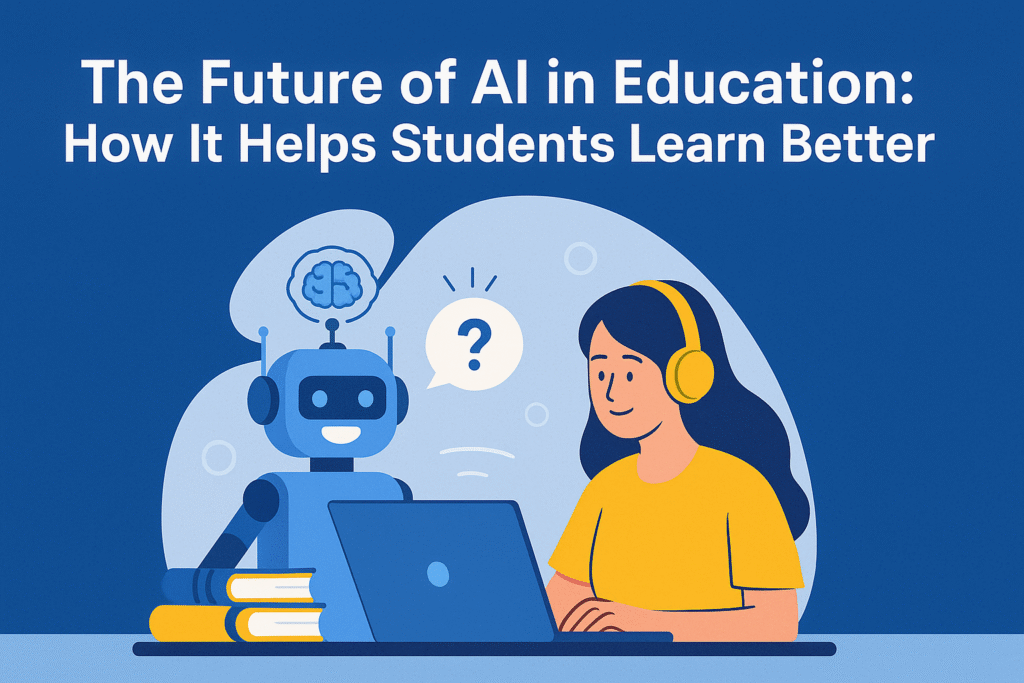In today’s digital age, Artificial Intelligence (AI) is transforming the way students learn, grow, and access education. From personalized learning experiences to virtual classrooms, AI-powered tools are creating new opportunities that were once unimaginable. This blog explores how AI is helping students in getting better education opportunities and why it has become an essential part of the modern learning ecosystem. AI helping students in getting better Education

Personalized Learning with AI andAI Helping Students in Getting Better Education
One of the most significant ways AI is revolutionizing education is through personalized learning. Every student has unique strengths, weaknesses, and learning styles. AI algorithms can analyze vast amounts of data to understand these differences and create customized learning plans. For instance, AI systems can track student performance and generate a report that identifies areas needing improvement. Teachers can then use these reports to provide targeted assistance, ensuring that no student is left behind.
Access to Global Knowledge AI Helping Students in Getting Better Education
AI-powered platforms are breaking geographical barriers by providing students access to high-quality education from anywhere in the world. Virtual classrooms, online courses, and AI-driven learning apps have made it possible for students in remote areas to learn from the best teachers globally. These platforms often generate performance reports that help students monitor their progress and plan their learning journey more effectively. This not only enhances knowledge but also boosts confidence in achieving academic goals.
Smart Tutoring Systems AI Helping Students in Getting Better Education
AI-based tutoring systems act as virtual assistants for students. These systems can answer questions, explain concepts, and even suggest additional study materials. Unlike traditional classrooms where one teacher handles many students, AI tutors provide one-on-one attention. The progress of the student is tracked in real time, and the system automatically creates a report to show how much the student has improved. Such detailed reports allow parents and educators to stay informed about the student’s academic growth.
Data-Driven Decision Making AI Helping Students in Getting Better Education
AI doesn’t just benefit students; it helps teachers and institutions make data-driven decisions. Schools and colleges now use AI analytics to evaluate student engagement, attendance, and performance. AI tools generate comprehensive reports that highlight patterns and trends in student behavior. These reports help educators make informed decisions about curriculum improvements, teaching methods, and resource allocation. With AI’s analytical power, institutions can offer better education opportunities tailored to student needs.
Language Translation and Accessibility AI Helping Students in Getting Better Education
Language has always been a barrier for many students seeking education abroad or accessing global resources. AI-driven language translation tools have solved this problem by making content available in multiple languages. For example, a student in India can now read and understand research papers in English, Spanish, or French through AI translators. These tools often come with usage reports to track the most translated subjects, ensuring that students get access to what they need the most.
AI in Career Guidance
AI is also helping students choose the right career paths by analyzing their interests, skills, and academic performance. Career counseling platforms use AI algorithms to generate personalized suggestions and create a detailed report outlining the best career options. These reports help students make informed decisions about higher education and job opportunities, ensuring that they choose a path aligned with their potential.
Challenges and Future Scope
While AI offers numerous benefits, it is essential to address certain challenges, such as data privacy and over-reliance on technology. Schools must ensure that AI systems use student data ethically and responsibly. Looking ahead, the integration of AI in education is expected to grow even more. From virtual reality classrooms to AI-driven research assistants, the future of education will be more interactive, personalized, and globally connected.
Conclusion
AI is not just a trend; it is a powerful tool shaping the future of education. By offering personalized learning, breaking language barriers, and providing valuable reports, AI ensures that students have better opportunities to learn and grow. As technology evolves, the collaboration between AI and education will create a world where every student can achieve their fullest potential.
